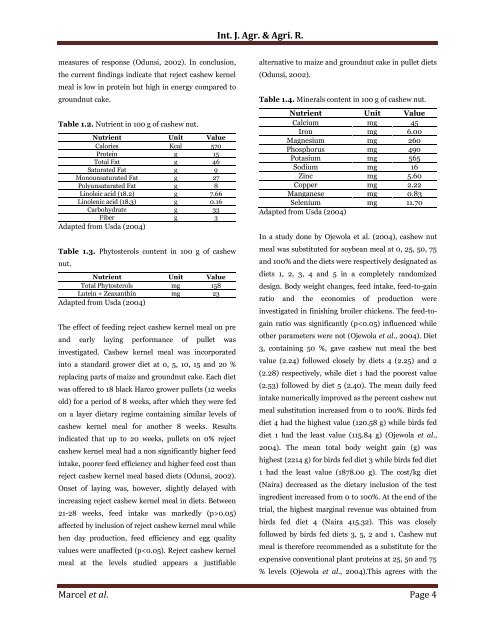Cashew in Breeding: Research synthesis
Abstract This review aims to show the research on the safe use of the cashew nut and its by-products in animal feed. They can replace corn and soy in animal diets. These investigations have involved chickens, rabbits, pigs, rats and cattle. Indeed, the cashew nuts and its by-products are rich in nutrients (carbohydrates, fats, minerals and proteins). They allow animals that eat them to make animal performances comparable to those obtained with corn and soybeans. The use of cashew nut and its by-products in livestock production is in addition to the nutritional, economic interest.
Abstract
This review aims to show the research on the safe use of the cashew nut and its by-products in animal feed. They can replace corn and soy in animal diets. These investigations have involved chickens, rabbits, pigs, rats and cattle. Indeed, the cashew nuts and its by-products are rich in nutrients (carbohydrates, fats, minerals and proteins). They allow animals that eat them to make animal performances comparable to those obtained with corn and soybeans. The use of cashew nut and its by-products in livestock production is in addition to the nutritional, economic interest.
You also want an ePaper? Increase the reach of your titles
YUMPU automatically turns print PDFs into web optimized ePapers that Google loves.
Int. J. Agr. & Agri. R.<br />
measures of response (Odunsi, 2002). In conclusion,<br />
the current f<strong>in</strong>d<strong>in</strong>gs <strong>in</strong>dicate that reject cashew kernel<br />
meal is low <strong>in</strong> prote<strong>in</strong> but high <strong>in</strong> energy compared to<br />
groundnut cake.<br />
Table 1.2. Nutrient <strong>in</strong> 100 g of cashew nut.<br />
Nutrient Unit Value<br />
Calories Kcal 570<br />
Prote<strong>in</strong> g 15<br />
Total Fat g 46<br />
Saturated Fat g 9<br />
Monounsaturated Fat g 27<br />
Polyunsaturated Fat g 8<br />
L<strong>in</strong>oleic acid (18.2) g 7.66<br />
L<strong>in</strong>olenic acid (18.3) g 0.16<br />
Carbohydrate g 33<br />
Fiber g 3<br />
Adapted from Usda (2004)<br />
Table 1.3. Phytosterols content <strong>in</strong> 100 g of cashew<br />
nut.<br />
Nutrient Unit Value<br />
Total Phytosterols mg 158<br />
Lute<strong>in</strong> + Zeaxanth<strong>in</strong> mg 23<br />
Adapted from Usda (2004)<br />
The effect of feed<strong>in</strong>g reject cashew kernel meal on pre<br />
and early lay<strong>in</strong>g performance of pullet was<br />
<strong>in</strong>vestigated. <strong>Cashew</strong> kernel meal was <strong>in</strong>corporated<br />
<strong>in</strong>to a standard grower diet at 0, 5, 10, 15 and 20 %<br />
replac<strong>in</strong>g parts of maize and groundnut cake. Each diet<br />
was offered to 18 black Harco grower pullets (12 weeks<br />
old) for a period of 8 weeks, after which they were fed<br />
on a layer dietary regime conta<strong>in</strong><strong>in</strong>g similar levels of<br />
cashew kernel meal for another 8 weeks. Results<br />
<strong>in</strong>dicated that up to 20 weeks, pullets on 0% reject<br />
cashew kernel meal had a non significantly higher feed<br />
<strong>in</strong>take, poorer feed efficiency and higher feed cost than<br />
reject cashew kernel meal based diets (Odunsi, 2002).<br />
Onset of lay<strong>in</strong>g was, however, slightly delayed with<br />
<strong>in</strong>creas<strong>in</strong>g reject cashew kernel meal <strong>in</strong> diets. Between<br />
21-28 weeks, feed <strong>in</strong>take was markedly (p>0.05)<br />
affected by <strong>in</strong>clusion of reject cashew kernel meal while<br />
hen day production, feed efficiency and egg quality<br />
values were unaffected (p





![Review on: impact of seed rates and method of sowing on yield and yield related traits of Teff [Eragrostis teff (Zucc.) Trotter] | IJAAR @yumpu](https://documents.yumpu.com/000/066/025/853/c0a2f1eefa2ed71422e741fbc2b37a5fd6200cb1/6b7767675149533469736965546e4c6a4e57325054773d3d/4f6e6531383245617a537a49397878747846574858513d3d.jpg?AWSAccessKeyId=AKIAICNEWSPSEKTJ5M3Q&Expires=1716541200&Signature=BcaUN2NV5kuz8UtJdlgqdwPsnnw%3D)












